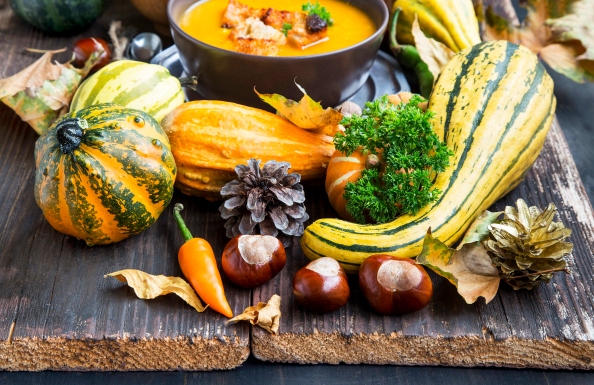
Seeing as how we are well into fall and the autumn season, today we are going to be talking about fall gourds and squash types — as they become quite prevalent in recipes and decorations this time of year — and the best varieties for cooking. First thing we need to talk about are the varieties of gourds, squash and pumpkins that are NOT EDIBLE.
Types of Gourds, Squash and Pumpkins You CAN NOT EAT
Unfortunately, this time of year, the grocery stores fill their produce sections with both inedible and edible gourds — quite often right next to each other. For a lay person, it could be quite difficult to tell if the gourd or squash type you are looking at is for cooking or simply for decoration. The following types of squash and gourds are only for decoration and should not be eaten:
- Angel Wing
- Apple Gourd
- Baby Bear
- Gooseneck
- Jack Be Quick
While the Jack Be Quick’s are the tiny miniature pumpkins you most often see for decoration this time of year, most of us recognize them as being inedible; the other types are a bit tougher to recognize. Angel wing can come in green, yellow or orange colors and look much like a striped zucchini. You can recognize an angel wing by the way it clubs outward at the fat end, like a medieval spiked club.
Apple Gourds looks a lot like a miniature watermelon, with emerald looking surface, but quickly turns a sickly amber yellow color when dried. This type of gourd should only be used for decoration. Gooseneck’s look similar to the apple gourd in size and color, but have a long goosenecked top half.
Baby bear’s look much like your traditional Halloween pumpkin, though smaller and in an almost perfect ball shape. These cause much of the confusion in the grocery stores, as they are not edible, but look very similar to edible pumpkins. Today, many grocery stores do not carry baby bears, due to the confusion they can easily cause.
Traditional pumpkins, like the type that we carve every year, are considered ‘edible, but not often used for cooking.’ You may be shocked to hear that the pumpkins so popular in America today are not usually considered a food-grade piece of produce, but it is quite true. While roasted pumpkin seeds are delicious, and even pumpkin meat can be delicious in some recipes, they are often considered a “garbage” gourd fed to pigs, grown to ridiculous sizes for show, or carved to be used as decoration for a night or two.
Squash and Gourds You Can Cook With
Now we will get into the good stuff, gourds and squash that can be cooked and turned into delicious recipes. While you may not be able to find all of these types in your local market, they can be ordered and shipped online, and can be found in local specialty markets. These will often show up in grocery stores in the fall, but if you can;t find them locally, try ordering them online to taste and try these squashes and gourds.
- Acorn Squash — One of the more popular squash types for cooking, these are aromatic and have a sweeter flesh than pumpkin. They are usually green all over, with a yellow spot where they touched the ground. Lock for a clean edged yellow spot; if there is too much yellow covering the squash, it is likely over-ripened.
- Blue Hubbard — A white gourd about the same size as an acorn squash, this variety comes from Marblehead, Massachusetts — developed in 1840 — and is less sweet and more of a cucumber flavor.
- Butternut Squash — Our personal favorites for soups and chili, the butternut squash is about the sweetest of the squash, though is meaty and rich in flavor. With less strings inside and a thin shell, it is also the easiest to work with, making it preferred for cooking.
- Cushaw — Most often used in the more savory dishes, this type has a long and slightly curved neck, is usually a brownish tan, and has a thin skin like butternut squash. These come in a dark green variety also that can be confused with the inedible gooseneck squash, so be wary.
- Turks Turban — Looking much like a pillowy turkish hat with orange and blue-green stripes, there is very little flesh on this variety, though it has one of the mildest flavors that makes it go well in a large amount of both sweet and savory recipes. The extra large seed size makes this a favorite for roasted seed recipes.
Our Favorite Recipes Using Gourds and Squash
There are so many great dishes you can add squash and gourds to in order to really round out the flavor of the dish and build extra layers of flavor within. Our favorite use of gourds is in chili, where the flesh of roasted gourds and squash can be used as a thickener and a base. The best way to start cooking with gourds and squash it to roast them and taste them to get a sense of their natural flavor. Once you know what each variety tastes like, incorporating them into your favorite recipes is a snap.
Check Out 55 Healthy Gourd and Squash Recipes HERE >>
And Make Sure to Follow Us For More Delicious Articles and Ideas…
